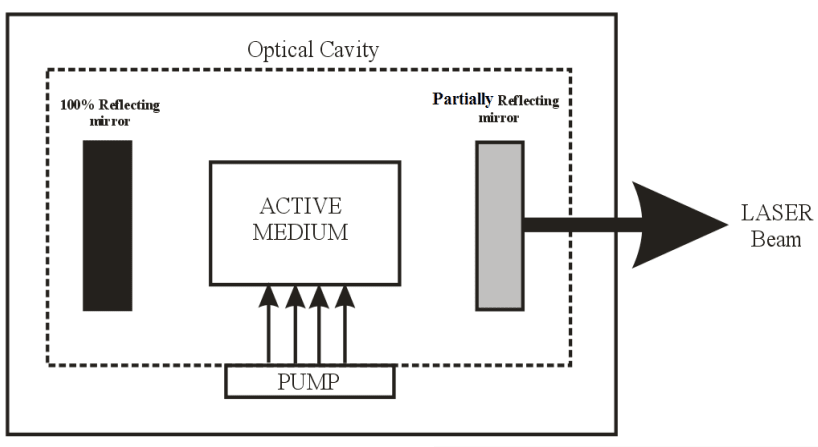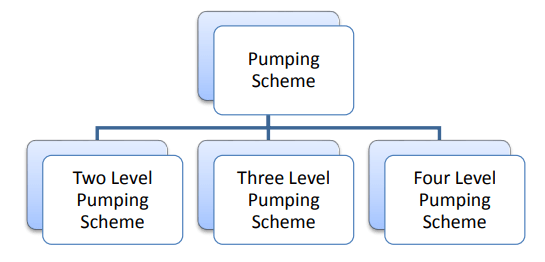Laser Introduction
LASER stands for light Amplification by Stimulated Emission of Radiation. The theoretical basis for the development of laser was provided by Albert Einstein in 1917. In 1960, the first laser device was developed by T.H. Mainmann.
The first laser, ruby laser was invented by Dr.T.H. Maiman in the year 1960. Since then, the development of lasers is extremely rapid. The laser action is being demonstrated in many solids, liquids, gases and semiconductor.
Further, a laser is a device that increases the intensity of light by focusing in a particular direction. Lasers not only increase the intensity of light but also generate light. Lasers emit light by stimulated emission of radiation, which increases the intensity of radiation. Some lasers produce visible light, and some produce ultraviolet or infrared rays. Lasers are different from conventional light sources. Lasers have some properties which are not found in traditional light sources like sun, electric bulb, and incandescent lamp.
Characteristics of Laser
-
Coherent: The Laser light is coherent. A Laser emits the light waves of same wavelength and in same phase.
-
Monochromatic: If the light coming from a source has only one frequency or single wavelength is called monochromatic source and the light is called monochromatic light. In case of Laser beam it has the wavelength confirmed to very narrow range of a few angstroms.
-
Divergence: Divergence is the measure of its spread with distance. The angular spread in ordinary light is very high because of its propagation in the form of a spherical wave front. The divergence in the Laser beam is negligible. A very small divergence is due to the diffraction of Laser light when it emerges out from the partially silvered mirror.
-
Directionality: An ordinary source of light emits light in all directions. In case of Laser the photons of a particular direction are only allowed to escape. Thus the Laser beam is highly directional.
-
Intensity: The intensity of ordinary light decreases as it travels in the space. This is because of its spreading. The Laser does not spread with distance. It propagates in the space in the form of narrow beam and its intensity remains almost constant over long distance.
Differences Between Ordinary Light And Laser Beam
| Ordinary Light | Laser Beams |
|---|---|
| In ordinary light the angular spread is more | In laser beam the angular spread is less. |
| They are not directional. | They are highly directional. |
| It is less intense | It is highly intense |
| It is not a coherent beam and is not in phase | It is a coherent beam and is in phase |
| The radiation are polychromatic | The radiations are monochromatic |
| Example: Sun light, Mercury vapor lamp | Example: He-Ne Laser, Ruby laser |
Basic Components of Laser System
A laser system consists of three important components. They are:-
Active medium (or) Active material
The active medium is the material in which the laser action takes place. It may be solid, liquid, or gas. The medium determines the wavelength of the laser radiation. Atoms are characterized by the large number of the energy levels, but all types of atoms are not suitable for Laser operation. Even in a medium consisting of different species of atoms, only a fraction of atoms of particular type have energy level system suitable for achieving population inversion. Such atoms can produce more stimulated emission than spontaneous emission causes amplification of light. These atoms are called active center. The rest of the medium acts as the host medium and supports the active medium.

Optical resonator
It is specially designed cylindrical tube having two opposite optically plane mirrors with active medium filled between them, one mirror is fully silvered and other is partially silvered and are normal to the light intensity by multiple reflection. Science active medium is maintained in population inversion state photon produced through spontaneous emission produces the stimulated emission in every direction. The photons having parallel to the axis of the resonators are only augmented while other are reflected trough the walls of resonator. If these unidirectional photons reach fully reflecting mirror they reflects and while transverse through the medium they produce the stimulated emission in other atoms thus increased stimulated photons reaches partially silvered mirror. At this end some photons are transmitted and other are reflects back in the medium. This process repeats itself again and again.

Pumping source
It is a system used to produce population inversion in the active medium.
Pumping Schemes:

-
Two level pumping scheme: A two level pumping scheme is not suitable for obtaining population inversion. The time span , for which atom has to stay at upper level , must be longer for achieving population inversion condition.

will be longer if is smaller i.e. is narrow. If is smaller, the pumping efficiency is smaller as a consequence of which less number of atoms are exited and population inversion is not achieved.
-
Three level pumping: Let an atomic system has three energy levels, the state is the ground state, is the metastable state and is the energy excited state. When light is incident, the atom are rapidly exited to upper most state . They comes back in the lower energy level. The atom does not stay at the level for long time. The probability of spontaneous transition is comparable to , is the metastable state. Science probability of transition is extremely small when the medium is expose to a large number of photons a large number of atoms will be exited to the higher energy level . Some of these atoms make spontaneous transition to the state through the radiative transition. As the spontaneous transition from to occurs rarely. The atoms get trapped into the state . This process continues when more than half of the ground state atoms accumulate at , the population inversion is achieved between and .

In this scheme a very useful-pumping process is required because to achieve population inversion more than half of ground state atoms must be pumped to the upper state.
-
Four Level Pumping: In four level pumping process the active medium are pumped from ground state to the uppermost level from where they rapidly fall to intermediate level i.e. meta stable state, leaving level empty. Now is populated inversely with respect to . If a triggering incident beam has frequency the transition is the stimulated transition. It could be the atom from may go to sponteniously. This transition is non radiative transition.
